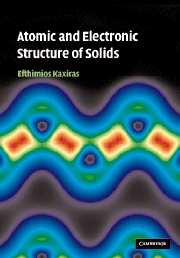Book contents
- Frontmatter
- Contents
- Preface
- Acknowledgments
- I Crystalline solids
- 1 Atomic structure of crystals
- 2 The single-particle approximation
- 3 Electrons in crystal potential
- 4 Band structure of crystals
- 5 Applications of band theory
- 6 Lattice vibrations
- 7 Magnetic behavior of solids
- 8 Superconductivity
- II Defects, non-crystalline solids and finite structures
- III Appendices
- References
- Index
8 - Superconductivity
Published online by Cambridge University Press: 06 July 2010
- Frontmatter
- Contents
- Preface
- Acknowledgments
- I Crystalline solids
- 1 Atomic structure of crystals
- 2 The single-particle approximation
- 3 Electrons in crystal potential
- 4 Band structure of crystals
- 5 Applications of band theory
- 6 Lattice vibrations
- 7 Magnetic behavior of solids
- 8 Superconductivity
- II Defects, non-crystalline solids and finite structures
- III Appendices
- References
- Index
Summary
Superconductivity was discovered in 1911 by Kamerling Onnes and remains one of the most actively studied aspects of the behavior of solids. It is a truly remarkable phenomenon of purely quantum mechanical nature; it is also an essentially many-body phenomenon which cannot be described within the single-particle picture. Because of its fascinating nature and of its many applications, superconductivity has been the focus of intense theoretical and experimental investigations ever since its discovery. Studies of superconductivity have gained new vigor since the discovery of high-temperature superconductors in 1987.
Overview of superconducting behavior
Superconductivity is mostly characterized by a vanishing electrical resistance below a certain temperature Tc, called the critical temperature. Below Tc there is no measurable DC resistance in a superconductor and, if a current is set up in it, it will flow without dissipation practically forever: experiments trying to detect changes in the magnetic field associated with current in a superconductor give estimates that it is constant for 106 – 109 years! Thus, the superconducting state is not a state of merely very low resistance, but one with a truly zero resistance. This is different than the case of very good conductors. In fact, materials which are very good conductors in their normal state typically do not exhibit superconductivity. The reason is that in very good conductors there is little coupling between phonons and electrons, since it is scattering by phonons which gives rise to resistance in a conductor, whereas electron-phonon coupling is crucial for superconductivity.
- Type
- Chapter
- Information
- Atomic and Electronic Structure of Solids , pp. 282 - 314Publisher: Cambridge University PressPrint publication year: 2003



